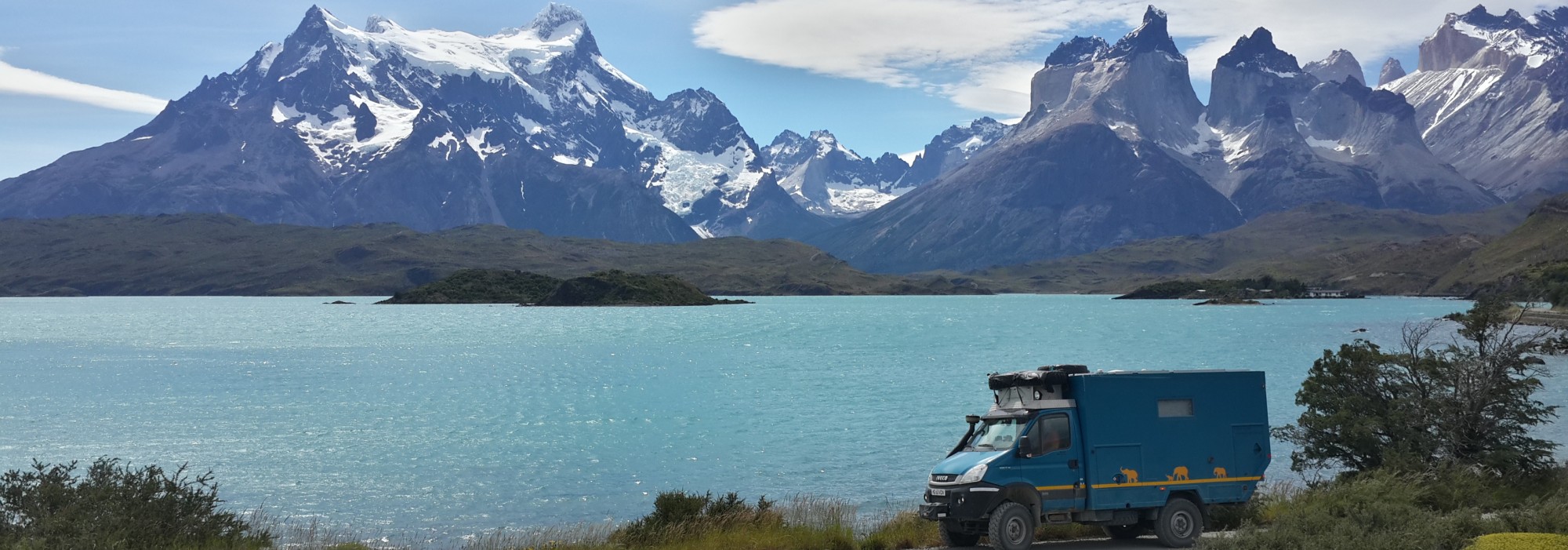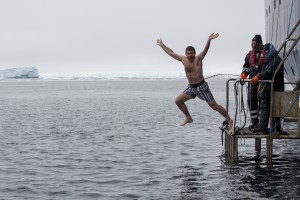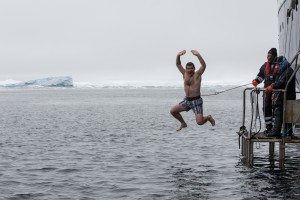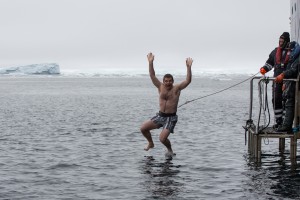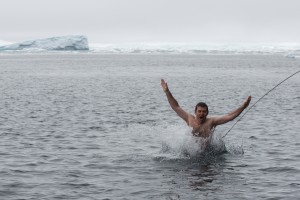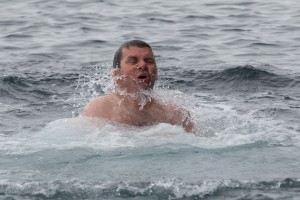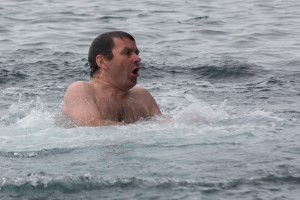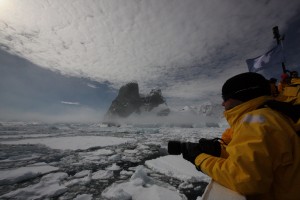 We could gush ridiculously about Antarctica but there simply aren’t enough superlatives in the English language to do so. Let’s start this Antarctica cruise blog with a simple ‘Wow!’ and take it from there…
We could gush ridiculously about Antarctica but there simply aren’t enough superlatives in the English language to do so. Let’s start this Antarctica cruise blog with a simple ‘Wow!’ and take it from there…
New skills in Drake’s Passage
First we had to get there; so let’s get the rough sea crossing out of the way before we start the main event. Drake’s Passage is the strip of ocean between the tip of South America and the Antarctic Peninsula, where the Pacific and South Atlantic Oceans meet (Click here for how we did a last minute Antarctica cruise deal)
It’s a two-day crossing of perpetually turbulent high seas and many who brave it suffer its effects to some extent or other. As we left Ushuaia and sailed down the calm Beagle Channel towards Drakes Passage, the first sign of the impending doom was the sick-bags strategically placed around the ship. For ease of ‘emergency’ rapid deployment, conveniently pre-opened bags were tucked behind the hand-rails at frequent intervals along the corridors! Hmmmm… me fears the worst! The expedition leader warned that the first day might be a bit ‘lively’. He was only wrong to the extent that he had made something of an understatement. Drakes Passage was extremely lively. And I wasn’t 🙁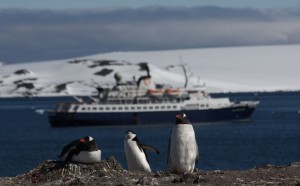
The wind was a steady 65 knots gusting up to 85 knots with waves around 8-10 meters high. Our ship was around 100m long; quite small for the high seas of ‘The Drake’s’, but the benefits of this nippy little vessel are more obvious on arrival when it comes to manoeuvering in the small destination bays of the Antarctic Peninsula.
To take our minds off the gales battering the outside of the ship, the expedition staff gave talks on the wildlife, geology, ecology and history of Antarctica. Marcus attended these interesting presentations, but I chose instead to adopt the ‘recline’ position in our cabin. Unable to even lift my head, I learned a potentially useful new skill of eating a tuna-cheese panini whilst simultaneously observing the cabin ceiling and trying to minimise the volume of falling tuna flakes debris. You may laugh, but it’s not a nice trait to mock the afflicted 🙂 . And before you ask… no, there are no pictures of this pitiful spectacle. Actually, the ship had a great system of live streaming the presentations to TV screens in the cabins, so nobody missed out if they were a bit too fragile to go see the talk in person.
 So Day One was rough, but the destination is so enormously, breathtakingly [add in own imaginative superlatives here 🙂 ] scenic and fascinating that any minor, shall we say… ‘discomfort’ that you may experience on the crossing, fades from the memory the instant you arrive.
So Day One was rough, but the destination is so enormously, breathtakingly [add in own imaginative superlatives here 🙂 ] scenic and fascinating that any minor, shall we say… ‘discomfort’ that you may experience on the crossing, fades from the memory the instant you arrive.
Exploring the Gerlache
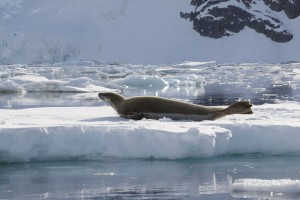 By Day Two of the crossing, conditions had calmed significantly and most passengers, including Yours Truly, were up and tucking into the absolutely delicious nosh in the dining room. The quality and selection of food was truly impressive and we take off our hats to the chefs delivering such top-notch food in the inevitably difficult conditions of a small ship on rough seas. Bravo chaps! As we approached the Antarctic waters we were all out on deck, excited to see our first icebergs and hump-back whales. Many pictures were taken by the passengers of the first distant iceberg, most of which were almost certainly consigned to the digital bin less than 24 hours later as we sailed far closer to much more impressive ice-towers drifting around us.
By Day Two of the crossing, conditions had calmed significantly and most passengers, including Yours Truly, were up and tucking into the absolutely delicious nosh in the dining room. The quality and selection of food was truly impressive and we take off our hats to the chefs delivering such top-notch food in the inevitably difficult conditions of a small ship on rough seas. Bravo chaps! As we approached the Antarctic waters we were all out on deck, excited to see our first icebergs and hump-back whales. Many pictures were taken by the passengers of the first distant iceberg, most of which were almost certainly consigned to the digital bin less than 24 hours later as we sailed far closer to much more impressive ice-towers drifting around us.
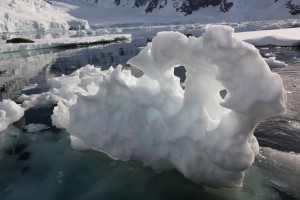 By Day Three we were in the channels between the islands of the Antarctica Peninsula and the real exploring began. For the next few days the ship took us slowly south down the Gerlache Straight. Twice a day we dropped anchor to launch shore landings into various bays on the islands and mainland, or zodiac motor-boat cruises around the shorelines and icebergs. The first day was snowy and a snowman was built on-deck, but from then we had nothing but beautiful clear conditions. We saw huge colonies of Gentoo, Chinstrap and Adelie penguins comically going about their business between their pebble nests, plus Crab-eater, Leopard and Fur seals drifting on ice platforms and lounging around on beaches. We saw lots of whales and a variety of birdlife including skuas, terns, albatross… and those are just the ones we can remember from those patiently explained by the expedition staff.
By Day Three we were in the channels between the islands of the Antarctica Peninsula and the real exploring began. For the next few days the ship took us slowly south down the Gerlache Straight. Twice a day we dropped anchor to launch shore landings into various bays on the islands and mainland, or zodiac motor-boat cruises around the shorelines and icebergs. The first day was snowy and a snowman was built on-deck, but from then we had nothing but beautiful clear conditions. We saw huge colonies of Gentoo, Chinstrap and Adelie penguins comically going about their business between their pebble nests, plus Crab-eater, Leopard and Fur seals drifting on ice platforms and lounging around on beaches. We saw lots of whales and a variety of birdlife including skuas, terns, albatross… and those are just the ones we can remember from those patiently explained by the expedition staff.
It’s all about the Ice
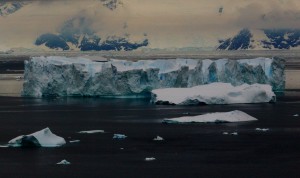 Fascinating and entertaining as the wildlife is, for us the main star of Antarctica’s ‘show’ is the scenery and particularly the ice. Gradually as we worked our way further south, the days became longer and longer, the scenery became more and more spectacular and the sea-ice became thicker and thicker. The icebergs vary in size, shape and form. Some are pure white and angular, dotted around the ocean like ginormous mounds of crumpled white paper littered across a blue floor. Others are eroded smoothly by sea action, with soft wavy lines of natural contouring. Then there are perfect flat panels, floating like mis-shaped tea-trays balancing seals and penguins, and there are random smaller floats of all shapes and sizes, bobbing between the ice-bergs.
Fascinating and entertaining as the wildlife is, for us the main star of Antarctica’s ‘show’ is the scenery and particularly the ice. Gradually as we worked our way further south, the days became longer and longer, the scenery became more and more spectacular and the sea-ice became thicker and thicker. The icebergs vary in size, shape and form. Some are pure white and angular, dotted around the ocean like ginormous mounds of crumpled white paper littered across a blue floor. Others are eroded smoothly by sea action, with soft wavy lines of natural contouring. Then there are perfect flat panels, floating like mis-shaped tea-trays balancing seals and penguins, and there are random smaller floats of all shapes and sizes, bobbing between the ice-bergs.
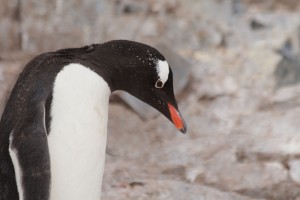 The MV Sea Adventurer has a 1A ice-breaker rating and was able to push through the sea ice much further south than the other cruise-boats so far this season. Leaning over the bow of the ship and watching the ice-breaking hull smash through the dense sea-ice was one of the most spectacular sights and experiences we have ever had. We intentionally chose to visit Antarctica at this early stage of the season so that the ice is still as pristine as possible yet not hampering the accessibility of the landings too much.
The MV Sea Adventurer has a 1A ice-breaker rating and was able to push through the sea ice much further south than the other cruise-boats so far this season. Leaning over the bow of the ship and watching the ice-breaking hull smash through the dense sea-ice was one of the most spectacular sights and experiences we have ever had. We intentionally chose to visit Antarctica at this early stage of the season so that the ice is still as pristine as possible yet not hampering the accessibility of the landings too much.
It is of course very cold down there, but during the comparative warmth of mid-afternoon the ice is continuing its seasonal melt-down. We saw ice-bergs crack apart and tumble up-side down in the ocean before our eyes; we heard the deep rumble of avalanches – ice cascading down mountainsides into the ocean leaving large clouds of ice-dust hanging in the air for minutes after the fall; and we saw deep crevices of pure aqua-marine blue ice melting away in the spring warmth.
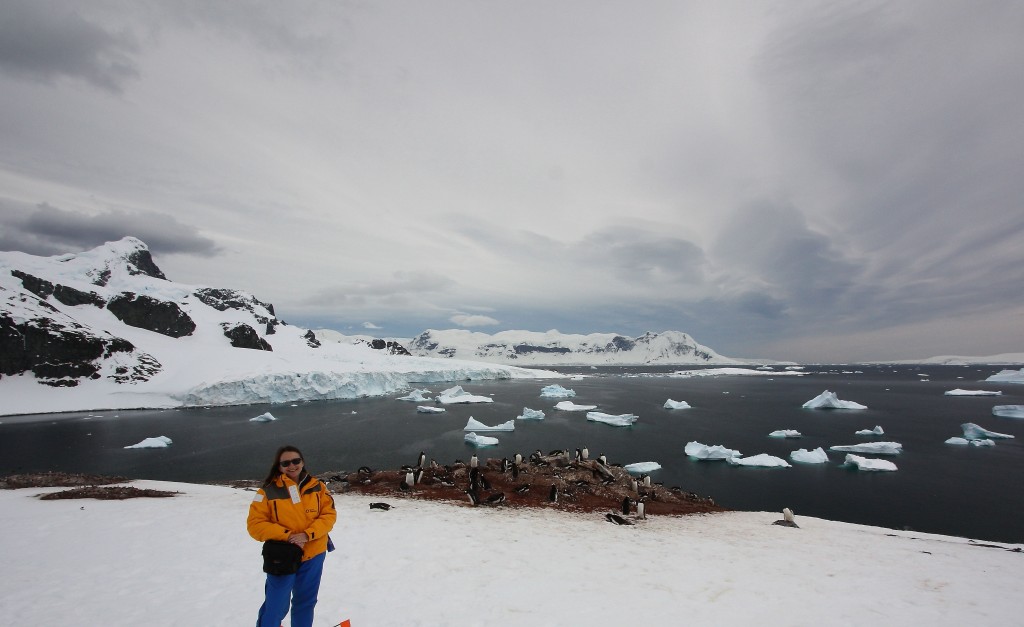 One of the most surprising aspects that we learned about ice, is the speed at which it shifts in the ocean. Out in the zodiac boats one day, we were in fairly open water with randomly scattered ice around us. We saw a flat section of break-away ice-shelf, so our expedition leader landed the zodiac for us to get out onto the ice-flow.
One of the most surprising aspects that we learned about ice, is the speed at which it shifts in the ocean. Out in the zodiac boats one day, we were in fairly open water with randomly scattered ice around us. We saw a flat section of break-away ice-shelf, so our expedition leader landed the zodiac for us to get out onto the ice-flow.
It was a marvelous experience but we had been literally less than one minute on the floating ice-sheet when we looked around to see ourselves suddenly surrounded by a dense field of floating sea-ice. Some pieces were huge. The gaps between them were filled with medium size chunks and the spaces between these had even smaller pieces trickling between them. Our expedition leader was keeping an eye on the flow, getting us back into the zodiac and out of the area through the few remaining spaces in the ice, but the speed at which we became almost totally surrounded – from open water to dense ice-field – was astonishing!
Polar Plunge
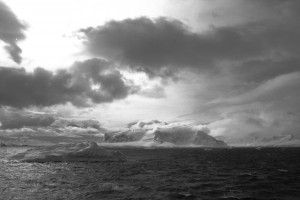 One of the ‘unique’ opportunities that arises for travelers to Antarctica is the chance to do the ‘Polar Plunge’ – taking a dip in the polar waters, temperature: -1°C (yes, that is a minus, not a grammatical dash for dramatic effect!). Quite why any sane person would avail themselves of such an opportunity is beyond my comprehension, but Marcus couldn’t let the golden moment pass. From the (relative) warmth of the upper viewing deck with a hot cup of tea in hand, I looked down to watch him take his turn to leap into the Antarctic Ocean amongst the icebergs. He was amongst a bewildering 53 other passengers who did this, including a very game 70 year old chap (British of course!). The certificate from the ship tells the tale, but I think the look on Marcus’ face when he surfaced tells it better 🙂
One of the ‘unique’ opportunities that arises for travelers to Antarctica is the chance to do the ‘Polar Plunge’ – taking a dip in the polar waters, temperature: -1°C (yes, that is a minus, not a grammatical dash for dramatic effect!). Quite why any sane person would avail themselves of such an opportunity is beyond my comprehension, but Marcus couldn’t let the golden moment pass. From the (relative) warmth of the upper viewing deck with a hot cup of tea in hand, I looked down to watch him take his turn to leap into the Antarctic Ocean amongst the icebergs. He was amongst a bewildering 53 other passengers who did this, including a very game 70 year old chap (British of course!). The certificate from the ship tells the tale, but I think the look on Marcus’ face when he surfaced tells it better 🙂
A very British spot
So it’s all ice and penguins then? Well yes, and no. There’s ice in abundance (obviously!) and the penguins do tend to take ‘center stage’ with their entertaining antics. But there are other attractions too. We visited the British ‘Base A’ (staffed by four Brits) where we found the old huts of a British World War II secret base – complete with a large range of relics from the scientific operations that took place there until the 1960s.
They operate a postal service from there too. You can post a letter from Antarctica with a penguin stamp (as you do 🙂 ) but all bets are off as to how long it may take for delivery. On another landing we visited the unstaffed Argentinian station ‘Almirante Brown’ and climbed the peaks with wide vistas overlooking the ship in the bay below us. There are ship-wrecks around the shores and relics of the historic whaling stations that operated in a few cases as far back as the late 1700s.
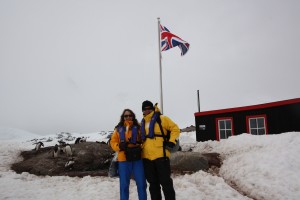 At the most southerly point of the voyage, daylight lasted for around 23 hours. The scenery and stillness at this point was truly breath-taking. The ship dropped anchor in a stunning bay for a few hours in late evening/over-night for us to take in the enormity of our surroundings. Photos simply cannot do justice to this extraordinary environment. Whilst taking in the exquisite light of the sun-set, followed less than an hour later by sunrise, we watched hump-back whales, seals and penguins dipping and diving in the ice-strewn glass-clear waters around us.
At the most southerly point of the voyage, daylight lasted for around 23 hours. The scenery and stillness at this point was truly breath-taking. The ship dropped anchor in a stunning bay for a few hours in late evening/over-night for us to take in the enormity of our surroundings. Photos simply cannot do justice to this extraordinary environment. Whilst taking in the exquisite light of the sun-set, followed less than an hour later by sunrise, we watched hump-back whales, seals and penguins dipping and diving in the ice-strewn glass-clear waters around us.
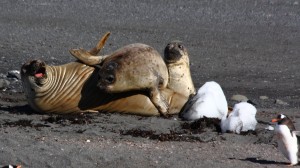 We then pushed further south into the Lemaire Channel, but eventually the ice-breaking had to end. The ship was making good progress through the pack-ice, but the Captain feared we could become stuck for some time in the rapidly shifting flows and made the decision to turn-back north. On the way back we stopped-off to do more zodiac landings in yet more stunning coves and bays along the Antarctic Peninsula and the surrounding islands. Our last land stop was the South Shetland islands before heading back north across the dreaded Drakes Passage again.
We then pushed further south into the Lemaire Channel, but eventually the ice-breaking had to end. The ship was making good progress through the pack-ice, but the Captain feared we could become stuck for some time in the rapidly shifting flows and made the decision to turn-back north. On the way back we stopped-off to do more zodiac landings in yet more stunning coves and bays along the Antarctic Peninsula and the surrounding islands. Our last land stop was the South Shetland islands before heading back north across the dreaded Drakes Passage again.
Drake’s the second time
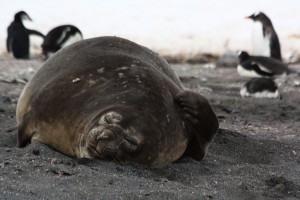 So the dreaded Drake’s Passage loomed again. The Captain predicted a smoother sea-state than on the way south, but we pre-emptively took our sea-sickness tablets and steeled ourselves for the worst. In fact, it turned out to be even calmer than the Captain had expected – we had sunny skies and calm ocean all the way back.
So the dreaded Drake’s Passage loomed again. The Captain predicted a smoother sea-state than on the way south, but we pre-emptively took our sea-sickness tablets and steeled ourselves for the worst. In fact, it turned out to be even calmer than the Captain had expected – we had sunny skies and calm ocean all the way back.
Even the Captain was surprised – in 17 years of sailing this route he had rarely seen the conditions so calm. We were of course delighted, but we had no idea of the next lovely surprise to come. Due to the tranquil conditions, we had been able to cruise at over 12 knots all the way back, over 50% faster than the 7-8 knots that we had managed on the way down.
As we neared South America we therefore had a day to waste before our due arrival back in Ushuaia. The expedition leader announced that we would be using the residual time to sail west-wards into the Pacific Ocean and to route back to Ushuaia via a close-in rounding of the famous Cape Horn. Sailing around Cape Horn is something I had wanted to do since reading Rosie Swale’s ‘Children of Cape Horn’ many years ago; for me this latest announcement was just the icing on the cake of an already extraordinary trip.
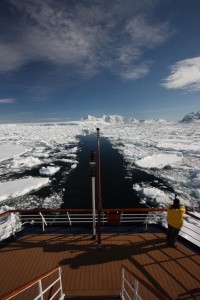 And we weren’t the only chirpy penguins on board. Most of the passengers were chuffed with this impromptu addition to our itinerary and cheered. There was one passenger however (Chinese I believe) who didn’t quite ‘get’ our enthusiasm. “What…”, he asked the expedition crew “… is the significance of this Cape Horn thing?”
And we weren’t the only chirpy penguins on board. Most of the passengers were chuffed with this impromptu addition to our itinerary and cheered. There was one passenger however (Chinese I believe) who didn’t quite ‘get’ our enthusiasm. “What…”, he asked the expedition crew “… is the significance of this Cape Horn thing?”
A simple factual statement regarding the world’s most southerly point on land, at which two great oceans meet would have probably sufficed to deal with the question. Instead, the explanation dwelled on the history of the Cape being one of the planet’s most treacherous routes for sea-farers… a point at which many sailors over hundreds of years have perished and lost their lives. I’m not sure whether the passenger was any more enthusiastic about the diversion as a result of this new knowledge 🙂 but conditions were beautifully calm and clear as we entered the Pacific Ocean and rounded the ‘mystical’ and beautiful Cape Horn to head back to Ushuaia.
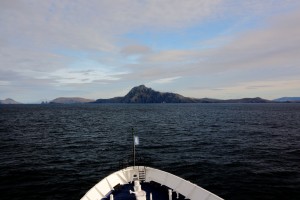 It was an amazing trip; truly an experience of a lifetime to see the planet’s last great un-spoilt wilderness. The trip was made all the more special by an excellent expedition leader and crew, not to mention of course, the very congenial company of our fellow passengers.
It was an amazing trip; truly an experience of a lifetime to see the planet’s last great un-spoilt wilderness. The trip was made all the more special by an excellent expedition leader and crew, not to mention of course, the very congenial company of our fellow passengers.
At the start of this Blog-post I was defeated in my search for appropriate superlatives and frankly I still haven’t found adequate words to describe the adventure. So we’ll just have to stick with ‘Wow’! 🙂
Click here for more pictures and a video in Antarctica Gallery
Click here for how we arranged the Last Minute Antarctica deal from Ushuaia
Link to next blog: ‘Home’ for Christmas Link to full South America Blog
Post-script on The Expedition Team – Quark Expeditions and the MV Sea Adventurer
We have no doubt that anyone who makes the voyage to Antarctica leaves the 7th Continent with a sense of awe. As a destination, Antarctica rather sells itself but we (and all our fellow passengers that we spoke to) feel that our voyage was truly enhanced by the exceptional service of our expedition leader Shane Evoy personally and his team. Shane’s passion for the region and his work, coupled with his skillful leadership of both his team and the passengers was impressive. Each of the expedition guides had expertise in subjects such as marine biology, geology, ecology, ornithology, history and photography, but they also each had years of experience doing research and living in the polar regions.
They were mostly English speaking from countries such as Canada, UK and New Zealand, plus one each from Argentina and Poland. They each delivered fascinating talks on-board but they also took us out in the zodiac boats to share their expertise and infectious enthusiasm ‘out and about’, helping us spot and identify the wildlife and explaining the animal behaviour.
Every one of them had passion, enthusiasm and great knowledge to pass on to us, however the icing-on the cake (so to speak) was the addition of renowned Russian Artic expert Dr. Nikita Osvyanikov. Nikita is a veteran of over 30 years’ polar study and documentary making. He is an expert in all types of polar wildlife but has specialized in Arctic polar bears. If you have watched tv documentaries on polar bears you have almost certainly seen his work; even the other expedition staff were somewhat in awe of his legendary status in their world.
And finally a mention for our ship, the MV Sea Adventurer operated by Quark Expeditions. It is a purpose-designed small expedition cruise ship, with the same ice-breaker category as the scientific polar survey ships. This meant that we didn’t have to turn around when the ice got tough and we had the benefit of purpose-designed spaces on-board (eg: great presentation space and extensive outdoor viewing decks and facilities on all sides of the ship). We had just 97 passengers on board.
Anyone familiar with large luxury cruise liners may find the MV Sea Adventurer lacking in facilities such as on-board spa and casino, but if this is your bag then an Antarctic expedition is probably not for you 🙂 . For us, it had the right balance of expedition capability for adventure with nice extra touches such as: comfortable en-suite cabins, tv screens in cabins to watch the on-board presentations (plus some limited appropriate entertainment programs like ‘Shackleton’ and ‘Happy Feet’ 🙂 ) and outstanding catering that far exceeded our expectations of what is possible under the circumstances. The ship loaned us comfortable and warm waterproof boots for the outside activities, and a brilliant extra was the issue of parka-jackets for us to keep after the voyage. These artic-quality double-layer, hooded jackets kept us super-warm and dry and will be our ‘ski-wear of choice’ for many years to come!
